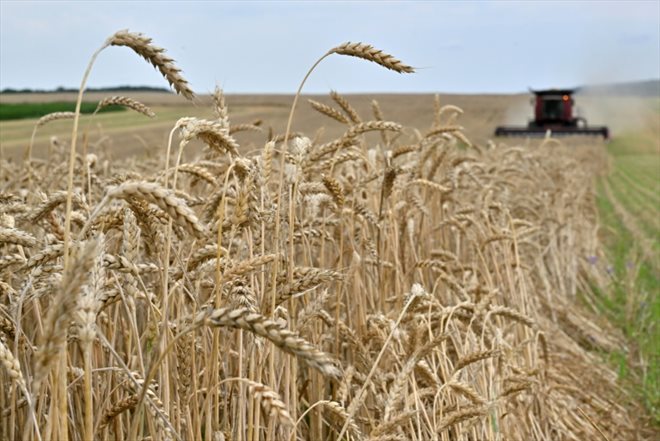Buoyed by an exceptional wheat harvest after last year’s record, Russia promises to continue to “dominate” the market in 2023-24, despite the uncertainties weighing on the safety of navigation in the Black Sea ( AFP/Archives/-)
Buoyed by an exceptional wheat harvest after last year’s record, Russia promises to continue to “dominate” the market in 2023-24, despite uncertainties weighing on the safety of navigation in the Black Sea, according to the firm Agritel (Argus Media group).
“Russian dominance will continue and it is necessary in a precarious global balance,” said Alexandre Marie, chief analyst for agricultural markets at Agritel, during a press conference Thursday in Paris.
World production of wheat, the cereal used to make bread, is expected to be less abundant in 2023-24 due to a decline in production in Canada and Europe, according to estimates published by the United States Department of Agriculture. in its monthly “Wasde” report in August.
World wheat supply will decline marginally by almost 3 million tonnes to 793.37 million, and stocks will contract slightly.
In this context, Russia is consolidating its position as the world’s leading exporter, with “an export capacity of 49 million tonnes of wheat”, i.e. 23% of world trade, – for an estimated production of 87.5 million tonnes – , “well above the average of the last five years”, according to Agritel.
“The Black Sea region, from Russia to Bulgaria via Ukraine and Romania, accounts for 40% of wheat exports in the world. Today, 30% of the export capacity of the Black Sea are at a standstill (corresponding to the Ukrainian ports of Odessa, Mykolaiv, Berdiansk and Mariupol) and 54% are at risk following the escalation of tensions”, according to Alexandre Marie.
– “Resilience” of Ukrainian agriculture –
Russian shelling of Ukrainian port infrastructure targets in particular the river ports of Reni and Izmail on the Danube route, while Ukrainian fire potentially threatens traffic via the Russian ports of Rostov-on-Don (Sea of Azov) and Novorossisk (at the end of the Kerch Strait).
Three other important ports in the Black Sea are currently in operation and are not threatened, those of Constanta, in Romania, and Varna and Burgas, in Bulgaria.
Russia has imposed itself in recent years on the international market, reassuring importers by the regularity of its production and the quality of its wheat, sold inexpensively, while improving its delivery capacity. For her, as for global food security, the greatest risk today is that of maritime security, underlines the expert.

Harvesting wheat on July 18, 2023 in a field near Kivsharivka, Ukraine (AFP/Archives/Sergei SUPINSKY)
He also notes the “great resilience” of Ukrainian farmers, Agritel estimating Ukrainian wheat production at 20.5 million tonnes for 2023-24, against 21.5 million the previous campaign and 33 million in 2021-22, before the Russian invasion.
Overall, the supply of milling wheat remains “substantial in continental Europe” (EU, Russia and Ukraine), despite the “downgrading” of a larger than usual part of milling wheat production to feed wheat (for animal feed) due to late rains.
France should do well, with a production of nearly 35 million tonnes of common wheat, including at least “17 million available for the export market”.
“In recent days, French wheat has become competitive again with Russian wheat – which has seen an increase in insurance premiums linked to war risks – with the hope of a reconquest of its traditional markets in North Africa, and potential purchases by China, which saw its quality of milling wheat decline after the rains.
© 2023 AFP
Did you like this article ? Share it with your friends with the buttons below.




